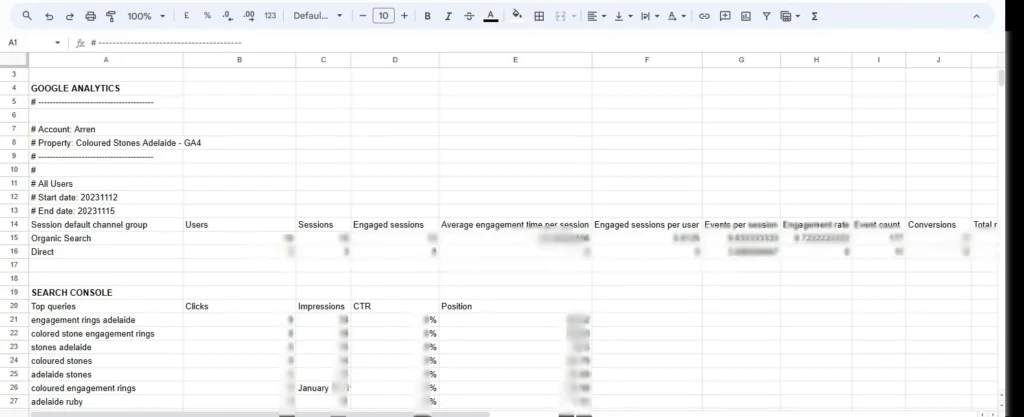The Power of Data Benchmarking in SEO

1. Identifying Key Metrics
Data benchmarking in SEO starts with identifying the most crucial metrics for your website. These metrics often include organic traffic, keyword rankings, backlink quality, and conversion rates. Organic traffic measures the number of visitors coming to your site from search engines, which is vital for understanding your SEO impact.
Keyword rankings help you see where your pages stand in search results for specific terms. Backlink quality evaluates the strength and relevance of external sites linking to yours. Lastly, conversion rates track how effectively your site turns visitors into customers or leads. Selecting the right mix of these metrics is essential for a comprehensive benchmarking process.


2. Choosing Benchmarks for Comparison
The next step is to choose appropriate benchmarks. This involves determining whether to compare your site’s performance against industry standards, direct competitors, or your own historical data. Industry standards provide a general idea of expected performance in your sector.
Comparing against competitors offers insight into where you stand in your niche market. Using your historical data helps in understanding your growth and identifying long-term trends. The choice of benchmark depends on your specific goals – whether to excel in your industry, outperform competitors, or surpass your past achievements. Carefully selected benchmarks give context to your data and a basis for meaningful comparison.
3. Utilizing SEO Tools for Data Collection
Utilizing key SEO tools – Google Analytics, SEMrush, and Ahrefs – is essential for any successful SEO campaign, as they provide critical data, thorough keyword research, and comprehensive backlink analysis:
- Establishing Key Performance Indicators (KPIs)
Begin by setting specific, measurable SEO goals, like increasing organic traffic or improving keyword rankings. This step is crucial for defining the direction of your SEO strategy. Then, select relevant KPIs aligned with these goals, such as website traffic, keyword positions, and conversion rates. Choosing the right KPIs is vital for accurately tracking progress and making informed strategy adjustments.
- Using Google Analytics for Website Traffic Analysis
Utilize Google Analytics to examine your website’s traffic sources, including direct searches, organic results, referrals, and social media platforms. Analyze user behavior metrics like average session duration and bounce rate to assess content engagement and relevance. Implement conversion tracking to understand the effectiveness of your site in prompting user actions, crucial for ROI evaluation and user journey optimization.
- Keyword Research with SEMrush
Employ SEMrush for comprehensive keyword research. Identify high-volume, low-competition keywords to target. Monitor the rankings of these keywords to gauge the effectiveness of your SEO strategies. Conduct competitive analysis using SEMrush to understand the keyword strategies of competitors, helping refine your approach and identify content opportunities.
- Backlink Analysis Using Ahrefs
Use Ahrefs to evaluate your site’s backlink profile, assessing the quantity and quality of backlinks. Monitor the growth of backlinks over time to understand the effectiveness of your link-building strategies. Analyze competitor backlink profiles to identify new link-building opportunities and understand industry link-building trends.











4. Analyzing Competitor Strategies
Understanding competitor strategies is a key aspect of SEO benchmarking. By analyzing the websites of your competitors, you gain insights into their SEO tactics – what keywords they target, how they structure their content, and the quality of their backlinks. This analysis helps in identifying industry trends and effective strategies that are yielding results for others in your field.
It also highlights gaps in your approach and potential areas for improvement. Analyzing competitors isn’t about copying their strategy, but rather learning and adapting successful elements to fit your unique context, thus enhancing your own SEO performance.
5. Establishing Performance Baselines
Setting a baseline is about understanding where your website currently stands. This involves analyzing your historical data to get a clear picture of your website’s performance over time. Look at trends in your key metrics over the past months or years.
This historical analysis helps in recognizing patterns, successes, and areas where performance has dipped. Establishing a baseline is crucial for setting realistic improvement goals. It provides a point of reference against which future performance can be measured, enabling you to track progress effectively and make data-driven decisions for SEO enhancements.


6. Goal Setting and Strategy Adjustment
To maximize the impact of your SEO efforts, it’s crucial to set data-driven goals and strategically adjust your tactics, leveraging insights from benchmarking data for continuous improvement and targeted results:
- Data-Driven Goal Setting
Begin by analyzing the data collected through your benchmarking process. Look for areas that need improvement or opportunities for growth.
Make sure your goals are Specific, Measurable, Achievable, Relevant, and Time-bound. For instance, aim to increase organic traffic by 15% in the next quarter or improve keyword rankings for 20 key phrases within six months.
- Assessing and Adjusting SEO Strategies
Review your existing content. Identify gaps based on keyword research and user engagement metrics. Plan to produce new content or update existing pages with the aim of improving relevance and quality.
Analyze on-page elements like meta tags, headings, and internal linking structure. Ensure they are optimized for both search engines and user experience. For example, update meta descriptions to increase click-through rates from search engine results pages.
Examine your current backlink profile. Develop a strategy to acquire high-quality backlinks and disavow harmful links. This might involve outreach campaigns or creating link-worthy content.
- Implementing and Monitoring Changes
Implement the identified changes methodically. Prioritize tasks based on their potential impact and ease of implementation.
Regularly track the progress of the implemented changes against your set goals. Use SEO tools to monitor keyword rankings, traffic statistics, and other relevant metrics.
SEO is an ongoing process. Based on the monitoring results, continuously refine and adjust your strategies. This might involve further tweaking of content, on-page elements, or backlink strategies to align better with your goals.
7. Monitoring and Ongoing Adaptation
The final step in the benchmarking process is continuous monitoring and adaptation. Regularly tracking your performance against the set benchmarks is crucial to understand the impact of your SEO strategies. Use the same tools to monitor ongoing progress and identify areas where you’re excelling or lagging.
This ongoing analysis will often reveal new opportunities for improvement and areas requiring additional focus. SEO is dynamic, with search algorithms and market trends constantly evolving. Therefore, it’s essential to adapt your strategies based on your monitoring, ensuring that your SEO efforts remain effective and aligned with the latest industry standards.
